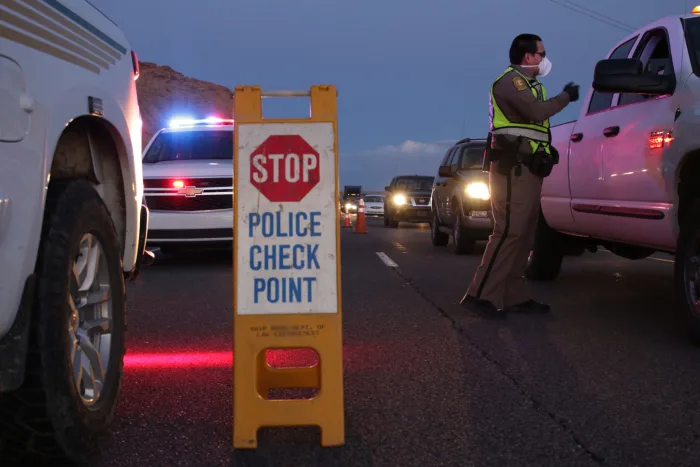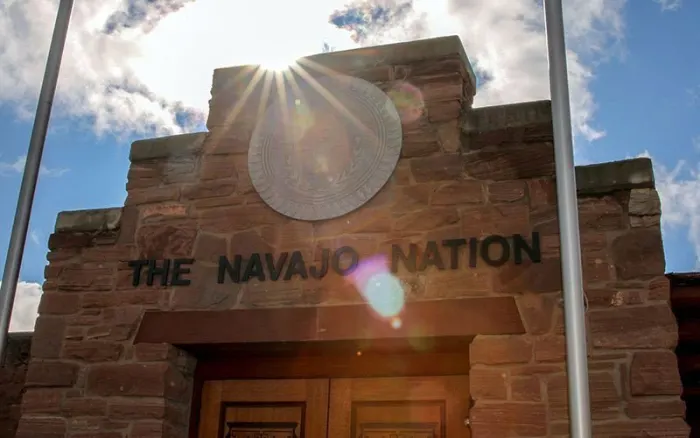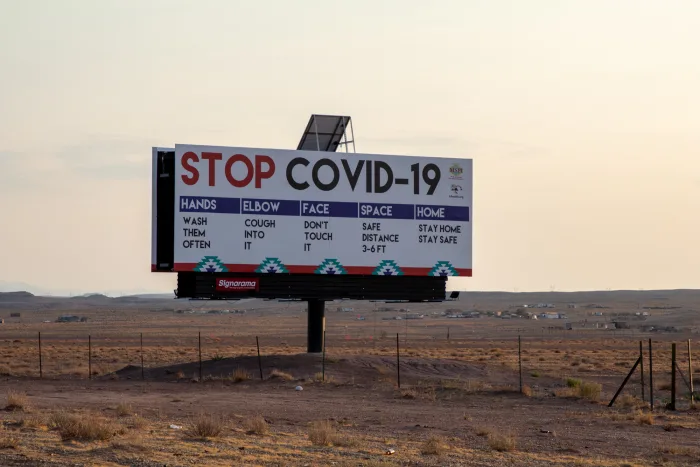Curfews saddled hundreds with citations, netted no money for Navajo police
An investigation into the aftermath of the Navajo Nation public safety COVID-19 measures by the Howard Center for Investigative Journalism found multiple breakdowns in their implementation
Noel Lyn Smith
Howard Center for Investigative Journalism/ Cronkite News

The Navajo Police Department has been holding checkpoints to share information about the curfew order on the Navajo Nation. (Courtesy of Farmington Daily Times/Noel Lyn Smith)
The first COVID-19 case on the Navajo Nation came in March 2020, and by the end of the month the tribe already had in place a curfew to keep residents home.
The curfew was among the most stringent measures any U.S. tribal or non-tribal government enacted to check the spread of the virus. Violators who were issued citations could face fines of $1,000 and up to 30 days in jail.
When the tribe faced a shortage of protective gear for public safety officers, many of whom were on the front lines of the pandemic, the tribal government passed legislation to direct revenue from fines to the Navajo Police Department.
At the time, former Navajo Nation Council Delegate Wilson C. Stewart Jr., who sponsored the dedicated fund to help the police, said the department should spend whatever it needed “to keep themselves safe, to keep our police officers safe and to keep our facilities as clean as possible.”
An investigation into the aftermath of the Navajo Nation public safety measures by the Howard Center for Investigative Journalism found multiple breakdowns in their implementation.
Even before citations were issued, the curfews faced sticky legal questions that public health and public safety officials had to sort through.
The nation’s nine prosecutorial offices didn’t receive guidance on how to handle the cases sent to them, and few were prosecuted.
And the designated fund for the police department to purchase personal protective equipment (PPE) never materialized because tribal administrators never set up the funding mechanism.
In the end, the investigation found, the most consequential legacy of the curfews is the impact on hundreds of residents who were issued citations and who still have them hanging over their heads as a part of their criminal history.
“The spirit of it was good – the intent – but there was nothing behind it to benefit anybody,” said former Navajo Police Chief Phillip Francisco.
Early challenges
Following the nation’s first COVID-19 case, the Navajo Department of Health issued the first public health emergency order on March 18, 2020.
Residents were placed under curfew starting March 30, 2020. Each day, residents were ordered to stay home from 8 p.m. to 5 a.m.
As COVID-19 cases climbed, health officials added lockdowns that spanned 57 hours during the weekend, starting April 10, 2020.
The police department faced two challenges in the early weeks of the pandemic, according to Francisco.
The first was keeping officers safe from the virus as they responded to calls for service.
Like many law enforcement agencies across the United States, the tribal police department faced shortages of face masks, gloves and other PPE as COVID-19 spread.

The second problem was enforcing the curfews.
The department was put in charge of enforcing them after the matter was discussed by administrators in the executive branch, including the president’s office and the health department, Francisco said.
The Division of Public Safety and the Navajo Department of Justice also had to figure out if the curfews were legal because there was no tribal law that specifically addressed people violating public health orders or adults breaking curfews.
The tribe has curfew laws for minors.
But because there was none for adults, officials used the offense of criminal nuisance, defined in the tribe’s criminal code as a person who “knowingly or recklessly creates or maintains a condition which endangers the safety or health of others.”
“There were a lot of challenges in trying to balance people’s rights and freedoms versus trying to enforce an order that was meant to protect the public from a health crisis,” said Francisco, who is now police chief of the Bloomfield Police Department in New Mexico.
Curfews in Navajo Nation begin
The police department was ready to begin issuing citations the first weekend the curfew went into effect.
In the days before, the department set up checkpoints to inform the public about curfews and to encourage them to stay home.
The former chief had the task of announcing that police officers would start citing people for not complying with curfews, outlining the measures on April 3, 2020, during a town hall that live streamed on the Navajo Nation Office of the President and Vice President Facebook page.
The first weekend of curfews officers issued 115 citations, according to a news release the police department issued on April 13, 2020.
“The enforcement was successful in that we saw a decline in the number of people traveling during the weekend,” Francisco said in the release. “An operation of this capacity takes a lot of planning and coordination, and our districts did a great job in enforcement efforts.”

Exceptions were made if travel was for emergencies, or if the person could prove they were an essential worker. “The intent and purpose of the curfew was to restrict the movement of individuals on the Navajo Nation and minimize the growth and spread of COVID-19 in communities,” the release stated.
As the number of COVID-19 cases declined and vaccines became available, the curfews became less restrictive. The daily curfew was discontinued on Aug. 6, 2021.
Officers across the police department’s seven districts issued 726 citations over the 16 months the curfews were in effect, according to statistics released by the police department.
The Tuba City District had the most citations at 207; the Chinle District, 172; Kayenta District, 169; Shiprock District, 56; Window Rock District, 44; Crownpoint District, 41; and Dilkon District, 37.
Figures included in quarterly reports from the Navajo Nation Department of Justice, however, show a higher number of citations.
Their figures show 1,280 total citations.
Lawmakers back police fund, but don’t set it up
In late 2020, former tribal council delegate Stewart sponsored a bill to direct revenue collected from curfew violations to the police department to buy PPE.
Members of the 24th Navajo Nation Council and then-President Jonathan Nez supported the financial initiative to help the police department.
The measure, however, required the Division of Public Safety to set up a special fund management plan, so that revenue from the citations could be put into a separate fund for police use.
Supporters of the bill said the fund management plan would prevent any fines from going into the tribe’s general fund.
In the tribal council resolution Nez signed, the public safety division had 30 days to present a fund management plan to two tribal council committees as part of the process to establish the fund.
No plan was ever presented, and the fund was not established, the tribe’s legislative services office and the controller’s office confirmed.
“No revenue source was generated due to FMP (fund management plan) not being established,” the police department said in response to questions about the fund.
Former Division of Public Safety Executive Director Jesse Delmar declined to comment about the fund and referred questions to the current division director. “I no longer have a voice with the Navajo Nation government,” Delmar wrote in an email on April 20.
Since no fund was set up, any amount collected from fines was deposited into the tribe’s general fund.
In the end, the police department did get enough protective gear, Francisco said. It received federal COVID-19 funds and was also able to use PPE that the tribe’s casinos weren’t using because they were closed.
At any given time, Francisco said, 25 percent of his officers were sick with COVID-19 and out of commission.
The virus also sickened or killed frontline workers from other agencies.
Among those who died from the virus were Navajo Police Officer Michael Lee, a 29-year veteran of the department, and Esther Charley, a criminal investigator. Both died in June 2020. Approximately 2,100 people died of COVID-19 on the Navajo Nation, according to the Navajo Department of Health.
Case dispositions unknown
Chief Prosecutor Vernon L. Jackson Sr. did not respond to repeated requests for information about how the citations forwarded to the nation’s prosecutors’ offices were handled.
Francisco, who left the police department at the end of 2021, said only a handful of cases were ever properly adjudicated.
“From my understanding, there was only maybe one or two cases that ever went in front of the judge and were ever found guilty,” he said.
Because of the pandemic, tribal courts were operating on a reduced schedule while the curfews were in effect.
As a result, Francisco said curfew citations went “on the back burner.”
“Most of those cases weren’t heard ever, or maybe a year and a half out,” he said.

Quarterly reports from 2020 and 2021 from the Navajo Nation Department of Justice mention that 1,280 citations were received by the prosecutors’ offices. But the reports mention only one case that resulted in a sentence.
In 2020, a defendant was sentenced to 30 days in jail after a plea agreement that included a charge of criminal nuisance for curfew violation.
“This defendant had prior criminal convictions and appeared for arraignment on the criminal nuisance charge after being arrested for a Violence Against Family Act offense,” according to the report.
A district prosecutor who did not want to be identified because the person was not authorized to comment, said citations came to the district offices without narratives that would help them prosecute a case.
References to citations in other reports indicate that many of those cited have not had their cases resolved because the courts have not summoned defendants to appear.
Most of those cited were released on their own recognizance, according to the justice department reports, with return dates for reappearance set many months into the future.
“Each district court has opted to treat these return dates differently, with some of the return dates being ignored completely,” according to a justice department report from January 2021.
This story was produced by the Howard Center for Investigative Journalism at Arizona State University’s Walter Cronkite School of Journalism and Mass Communication, an initiative of the Scripps Howard Foundation in honor of the late news industry executive and pioneer Roy W. Howard. Contact us at howardcenter@asu.edu or on Twitter @HowardCenterASU.
For more stories from Cronkite News, visit cronkitenews.azpbs.org.






